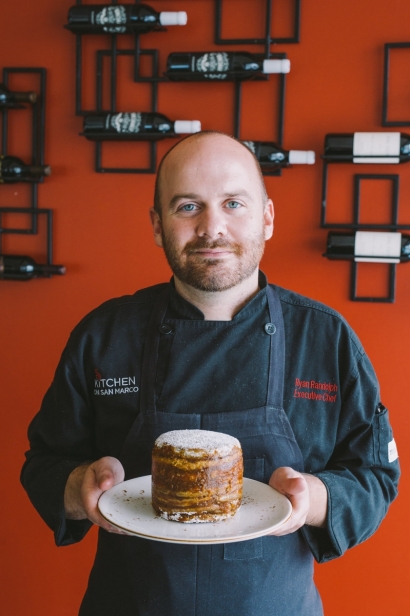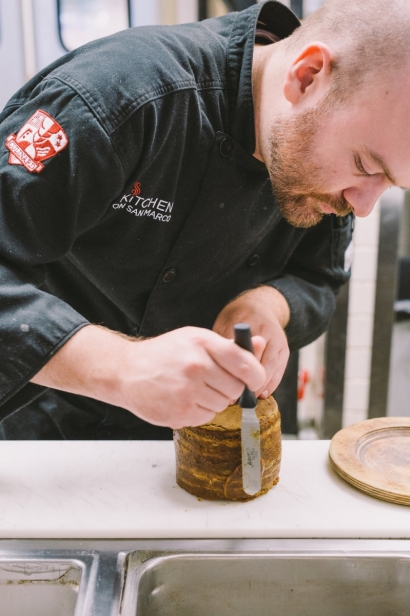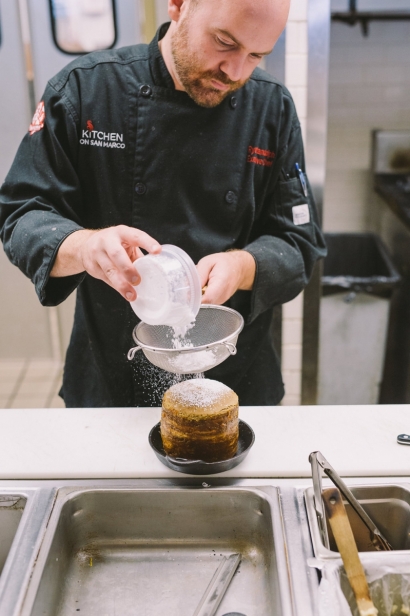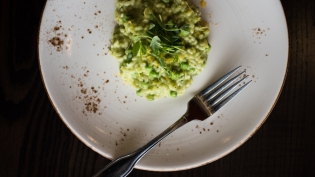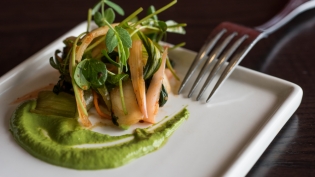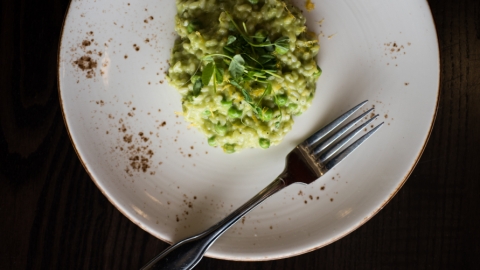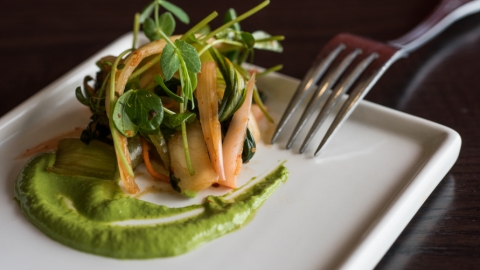The Taste of Tradition
Watching a mother or grandmother cook, observing her hands skilled at preparing and combining ingredients—these moments are the training camp in the life of many young culinarians. They create a foundation for experimentation and exploration. Later, formal education and on-the-job experience build on those formative roots, when simple raw materials were transformed into something more. As a cook’s expertise evolves with a desire to innovate, sometimes it is a return to the past that inspires new flavors for the table.
For Ben Loose, chef-owner of Gas Restaurant in St. Augustine, honoring his family’s traditions is evident as soon as you walk through the door. There, a butcher’s block table greets you, a souvenir of his grandfather’s butcher shop back in Pennsylvania. Once a perfect square, the edges of the solid oak table are now worn smooth from years of slicing and shaping fresh meat.
Loose proudly carries on this legacy by serving hand-cut steaks and other meats at his restaurant, having learned much of the techniques at his grandfather’s business. He spent his early years in Lancaster County and then, after moving with his parents to Florida, returned to spend summer months with his grandparents in an area surrounded by farms that raised both vegetables and livestock. Loose recalls going to the stockyards on Mondays with his grandfather to buy the animals that would then be butchered and sold at a farmers’ market on Friday.
“It was an all-family business—my grandfather, uncles, brothers all worked together. I would ride with my grandpa to the auctions and then we would bring the pigs and cows back to the shop. I had to earn my keep when I visited in the summer, and would go to the markets with him to sell the meat,” said Loose. Growing up around the butchering business, and seeing everything from the slaughter to the grinding to making bacon and sausage, he learned at an early age where meat came from. “It never seemed strange,” he said. “That’s just the way it is.”
Besides hands-on experience with his grandfather, Loose also spent time in the kitchen cooking with his mother. “My mom bakes a lot and some of our desserts are based on her recipes,” said Loose. “She encouraged me to pursue a career in foodservice. Occasionally we would eat at a steakhouse where there was an open kitchen; she noticed how I liked to watch the cooks, and thought that would be a good job for me.”
After several years working in various restaurants, refining his skills along the way, Loose was offered an opportunity to open his own place. He jumped at the chance to create an eatery that would serve hand-cut, high-quality meats and locally sourced vegetables.
“What we’re after is real food. We eat this way at home—it’s what we feed our family and we look at our customers as family,” he said. “I’ve had people come in, tourists, who told me they bought meat from my grandfather. That’s been pretty special. He was able to visit once and was very impressed. He loved a good pork chop and was happy to see that on the menu.”
Family traditions also made an impression on Chef Ryan Randolph while growing up in Tennessee. Randolph discovered the value of sustainable living and seasonal eating at an early age on his family’s farm, and he has incorporated many of those food memories into the dishes at Kitchen on San Marco.
During apple season in the fall and winter, for instance, the chef will add one of his favorite desserts, the stack cake. Traditionally served at weddings in Appalachia, individual layers were provided by family and friends attending the ceremony and the stack cake was then assembled by the bride’s family using dried apples, apple butter and a sorghum glaze.
“The tradition started because brides had no money or time for an elaborate cake, so family and friends would each bring a layer. The more stacks on a cake, the more prominent the family,” said Randolph. Wedding celebrations would customarily take place in the cooler months because that was the season for butchering hogs, harvesting apples and processing sorghum syrup, food in abundance in the Appalachian region.
In addition to weddings, Chef Randolph’s family tradition was to have a stack cake for holiday gatherings. He watched his grandmother and aunts prepare many a cake over the years. His grandmother would pick, peel and thinly slice the apples, then dry them—on her roof.
“She would put a tarp on the roof and then throw the slices up there to dry for 24 hours,” Randolph said. To protect the apples, his grandmother would sit in her rocking chair on the front porch armed with her shotgun to deter any opportunistic birds from helping themselves to the key ingredient of the holiday dessert.
The cake is flavored with cinnamon and sweetened with sorghum. The dried apples are cooked down into a thick butter. “We would have at least six layers of the cake, each individually baked in cast-iron pans. The cake would not have decorations; it was just real simple looking. Making the cake was such a big process for my grandmother and aunts,” said Randolph. “It’s funny to see something I associate with childhood being photographed so intensely.”
When we pass along recipes and skills, we honor our family traditions while preserving our cultural roots. It’s a way of keeping our ancestry alive, with the hope that young and future culinarians are watching, learning traditions to make their own.
Photograph of Ben Loose of Gas Restaurant was taken by Amy Robb.




